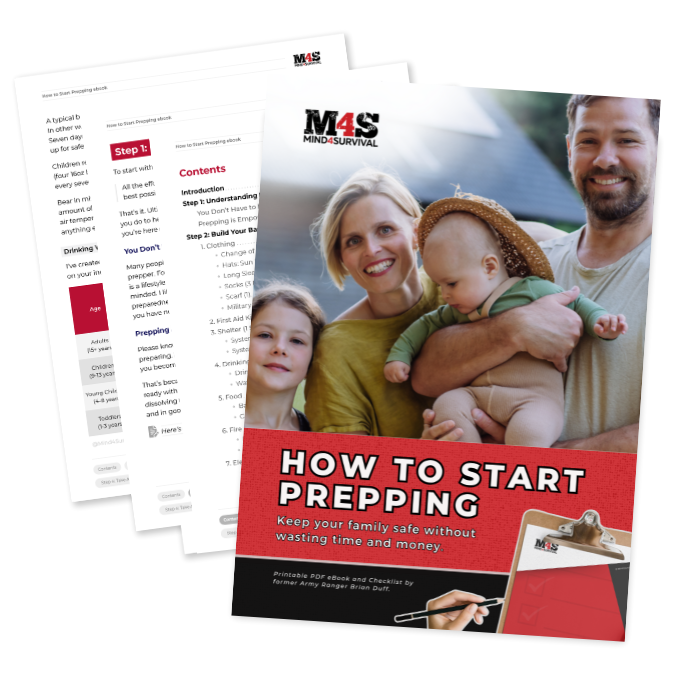Urban Coyotes in the U.S.: What You Should Know
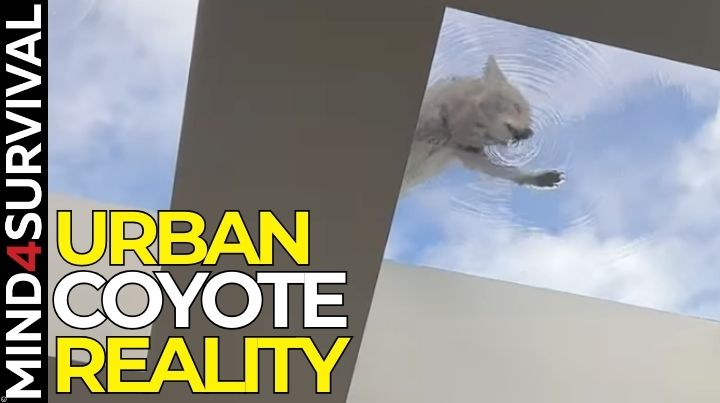
You see an coyote in the street—middle of the day. You're not in the woods or on some remote trail—this is suburbia. Your kid's school is a block away. And this isn't some rare event. Urban coyotes are showing up more frequently in neighborhoods, school zones, and parks—a change in your environment that we should pay attention to.
While coyotes are probably not your most significant risk, they are wildlife doing what wildlife does. Unfortunately, when wildlife like coyotes are out living their best possible urban lives, that sometimes means doing so at the expense of you, your families, and your pets. Therefore, while they are doing what wildlife does—adapting to their environment, you should, at a minimum, adjust your mindset and situational awareness to our new environment.
After all, coyotes are in every U.S. state except Hawaii. And whether you live in the suburbs or ten miles down a dirt road, it's worth understanding how these animals operate. Not because they're monsters—but because they're intelligent, increasingly common, wild animals that are becoming surprisingly comfortable living amongst us.
TL;DR Coyotes are showing up more often in U.S. neighborhoods. Attacks on people are rare, but the risk to pets and exposure to disease is real. Understanding coyote behavior helps you protect your family, animals, and property—without overreacting.
Coyote Stats That Matter
- Population: Estimated 1.5 to 4 million in the U.S.
- Range: All 49 continental states (yes, even New York City and Los Angeles).
- Attacks on Humans (1970–2015): There are 200–250 documented cases in the U.S.—averaging around 4 to 6 per year. Of the reported attacks, 160 were in California alone, with the majority concentrated in Southern California (CA Coyote Info).
- Confirmed U.S. Fatalities: One (1)—the death of 3-year-old Kelly Keen in Glendale, California, in 1981.
- Reproductive Adaptation: When heavily hunted or trapped, coyotes respond with more females having litters, and those litters being larger. A typical litter is 4–7 pups but can jump to 10–12 when under pressure. (e.g., Killing coyotes doesn't reduce their numbers long-term—it accelerates reproduction and increases their population.)
The Author's Urban Coyote Perspective
Coyotes are survivors. They're not the enemy—but they’re not Disney animals either. Our job is to keep them wild by removing easy food, securing our pets, and making them uncomfortable when they come too close. ~Brian Duff
View this post on Instagram
Kelly Keen: The Attack That Changed Urban Wildlife Policy
Kelly Keen was 3 years old. It was August 1981 in Glendale, CA. She just stepped outside onto the driveway. A coyote—grabbed her and dragged her across the street. Her father chased it down, retrieving Kelly. She was rushed to the hospital but died hours later in the hospital.
From what I can find, it's the only confirmed fatal coyote-caused death in U.S. history. Over 50 coyotes were trapped and killed in the area following the attack. That attack made it clear—coyotes weren't just an issue for hikers or farmers anymore. They were showing up where we live, work, and play.
That increased frequency and closer overlap between humans and wildlife increases the potential for a dangerous encounter with a coyote. It's a little bit like living with bears in Alaska. Predators do what predators do. You don't have to live in fear—but you do need to respect the fact that these cunning opportunists (with teeth) are out and about.
Urban Coyotes: Adaptable and Bold
Coyotes aren't just surviving in cities. They're thriving:
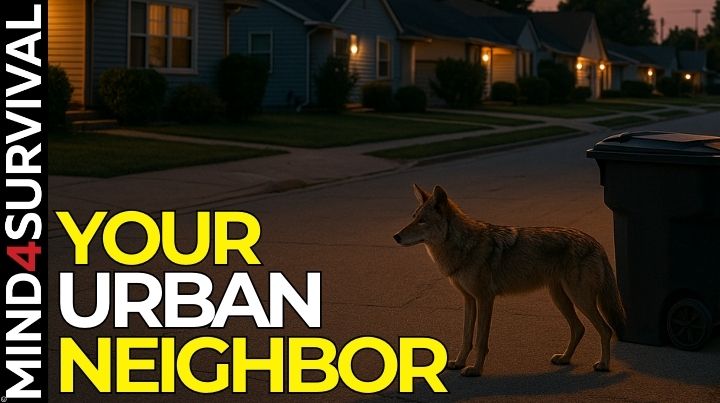
- Los Angeles: Scat studies show domestic cats and small dogs comprise as much as 20% of urban coyote diets.
- Chicago Metro: One of the longest-running urban coyote research projects has tracked over 1,000 GPS-collared coyotes.
- Behavior: Once mostly nocturnal, urban coyotes now operate in daylight hours. They learn trash pickup schedules. They're used to human movement and have become part of the urban landscape.
And no, they're not always alone. They often travel in mated pairs or loose family groups—especially during breeding and pup-rearing seasons.
Diseases You Should Know About
For most people, what might be most concerning is that coyotes can carry disease—and they may be leaving traces of it in places you or your pets come into contact with daily. You don't need to be bitten to be exposed.
Is your dog sniffing or licking infected feces on a walk? That's a potential route for exposure to parasites. Are you working in your yard where coyotes have passed through? Same thing. And if a coyote does get into it with your dog, even a quick bite can transmit mange, distemper, or worse.
Coyotes are part of the environment now. The closer they get, the more overlap there is with your daily life—and your animals' health.
- Rabies: Less common than in raccoons or skunks, but still present—especially in the Southwest.
- Mange (Sarcoptic): Causes fur loss and aggression. Highly contagious to dogs.
- Echinococcus tapeworm: Carried in feces. It can cause deadly cysts in humans and pets.
- Distemper and Parvo: Coyotes are carriers. It can infect unvaccinated domestic dogs.
These risks show up in everyday places—yards, parks, sidewalks—where your pets roam and you spend time outside. With that in mind, it's worth stepping back and looking at how you can keep yourself and your pets safe and secure with coyotes as part of the picture now.
Coyotes and Urban Ecosystems
Because larger carnivores like wolves and bears have been mostly eradicated, the coyote has moved up the predator pecking order.
That puts coyotes at the top of the food chain in many urban and suburban ecosystems—making them the apex predators. If you're an urban, or suburban, chicken or rabbit rancher 😂, you'll definitely want to take precautions for your urban herd.
However, coyotes play a much bigger role than most people realize. They aren't just scavengers—they're considered keystone predators. They help keep ecosystems balanced by controlling smaller predator and prey populations. (Source)
Frequently Asked Questions About Coyotes

Q: Are coyotes dangerous to people?
A: Not usually. Attacks on humans are extremely rare. There's been only one confirmed fatal coyote attack in U.S. history. But they're getting more comfortable around people, so awareness matters.
Q: How do coyotes pose a threat to pets?
A: Two main ways: direct attacks (especially on small pets) and disease. Your dog doesn't have to be bitten—contact with infected feces can spread parasites or viruses.
Q: What should I do if I see a coyote near my home?
A: Don't feed it and don't ignore it. Don't run from it. Make noise and haze it: face it, shout, wave your arms. Secure trash, and keep pets indoors or close. Coyotes adapt quickly, especially when we make it easy for them.
Q: What's an effective deterrent?
A: Motion-activated lights or sprinklers. Coyotes are cautious, especially around unpredictable stimuli. Motion lights, sprinklers, or even noise machines can help keep coyotes away.
Q: Can coyotes carry rabies or other diseases?
A: Yes. Rabies is rare but possible. Mange, distemper, and tapeworms are more common.
Q: Why are coyotes more visible now than they used to be?
A: They've adapted to urban and suburban life. Urban-wildland interface, easy food sources (trash, pets, rodents), and relatively no predators mean they're here to stay.
Q: When are coyotes most aggressive?
A: Late winter to early spring (Feb–May). That’s mating season and denning time. Coyotes will defend dens with pups and can become territorial. Also, in late winter, food is scarce—so they’re hungrier and bolder.
Fast Facts for Field Use
- Litters: 4–7 pups (more when under population pressure)
- Territory: 4–15 square miles (shrinks in cities)
- Diet: Rodents, fruit, pets, trash, birds, carrion
- Speed: Up to 40 mph
- Climb fences: Yes (up to 6 feet or higher with leverage)
- Swim: Yes
- Active: Year-round, more active at dusk/dawn but increasingly seen in daylight
The Bottom Line on Urban Coyotes
Coyotes aren't something to panic over—but they're worth paying attention to. They're intelligent and adaptable and show up more often where people live. Knowing how they operate helps you avoid problems before they start.
Keep an eye out, protect your animals, and treat coyotes for what they are: wild animals living closer than most people realize.
Do you have coyotes in your area? Tell us about your coyote experiences in the comments below!
Additional Resources
- Camping with Kids: A Playground for Survival Skills
- How to Start Prepping: Beginner’s Emergency Guide
- FEMA Emergency Supply List. Will You Be Ready?
- Urban Coyote Project
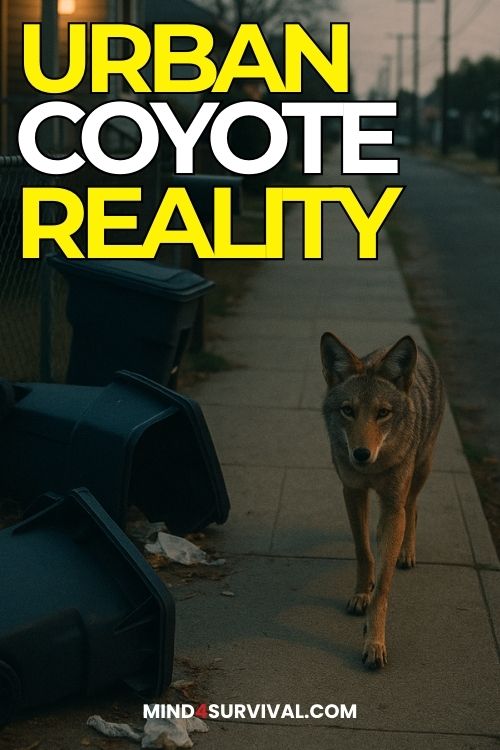
Related Articles
FREE Guide
Read the Best Seller
Join Mind4Survival
Stay informed by joining the Mind4Survival! 100% Secure! 0% Spam!
Affiliate Disclosure...
Mind4Survival is a free, reader-supported information resource. If you make a purchase through our link, we may, at no cost to you, receive an affiliate commission.
Do You Want To Be Ready No Matter What?
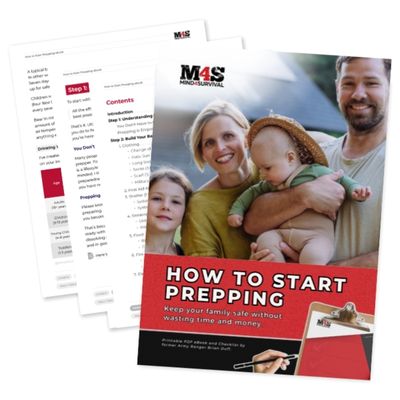
Download our free 39-page guide with interactive, 7-Day Emergency Kit Checklist and take the first step toward real preparedness.
- Know exactly where to start.
- Save time and money.
- How-to build a complete Basic Emergency Kit.
- Level up your safety and security.
Join Mind4Survival
Stay informed by joining the Mind4Survival! 100% Secure! 0% Spam!




